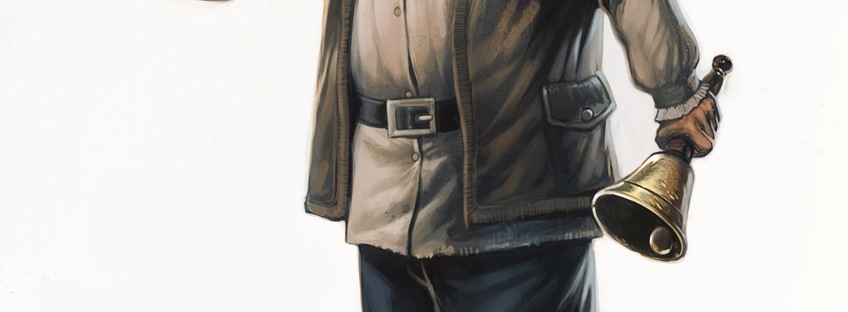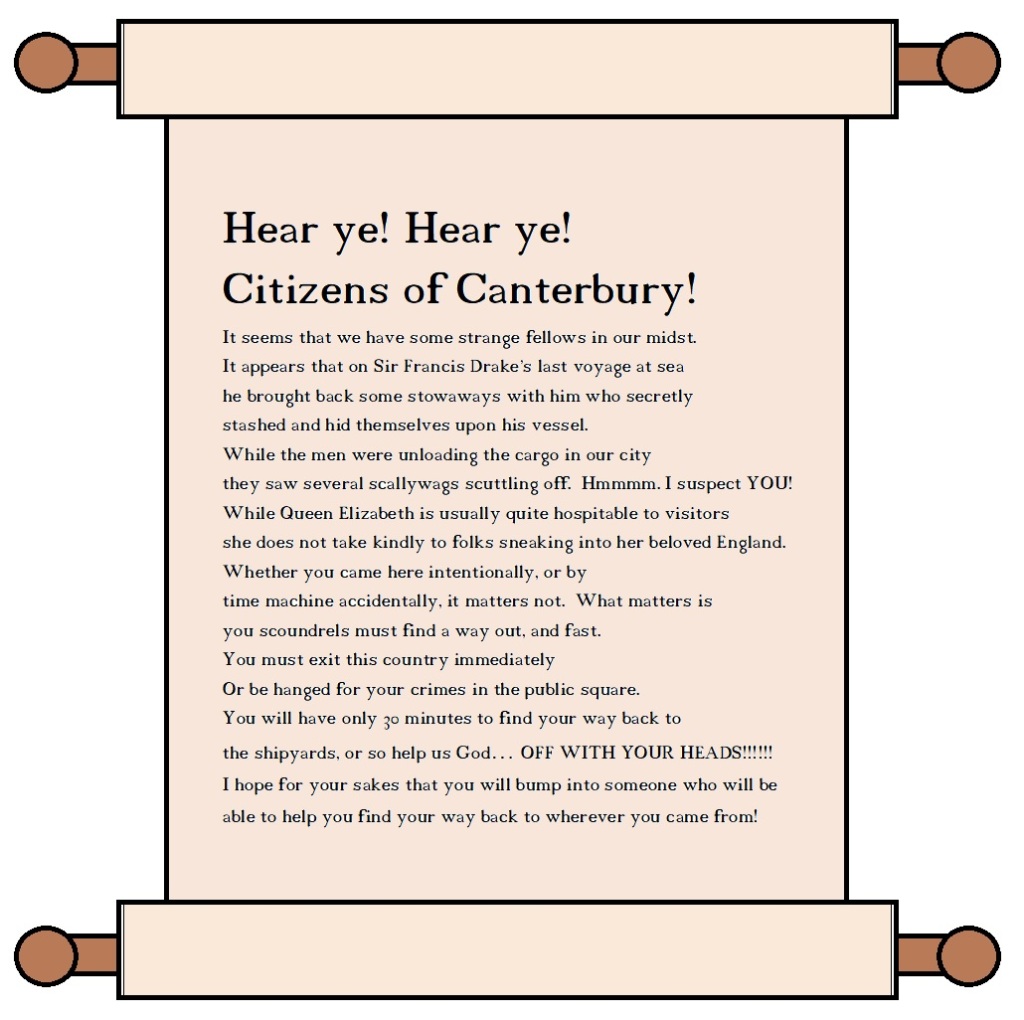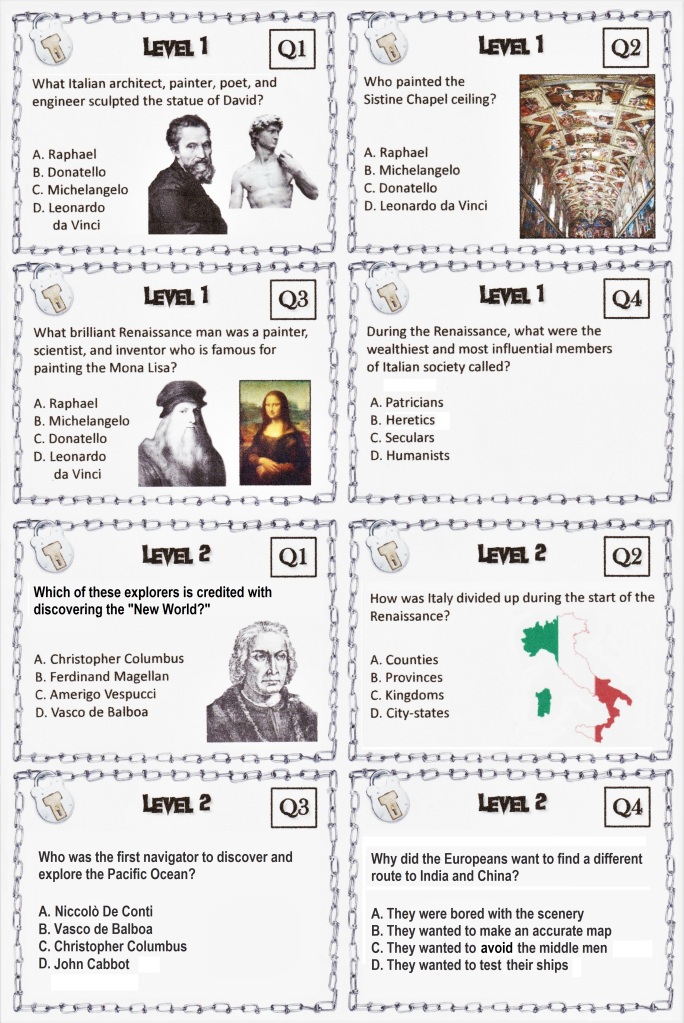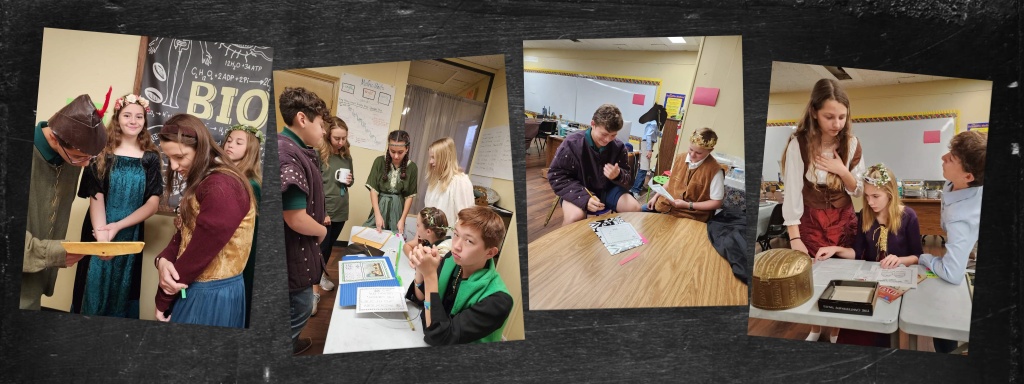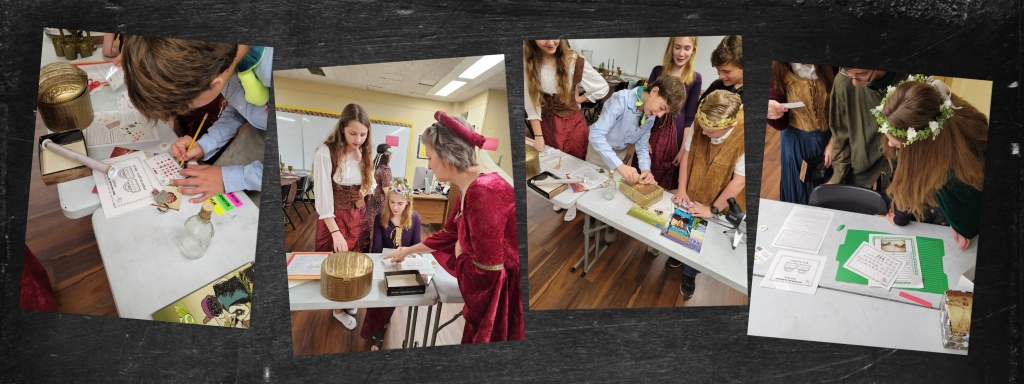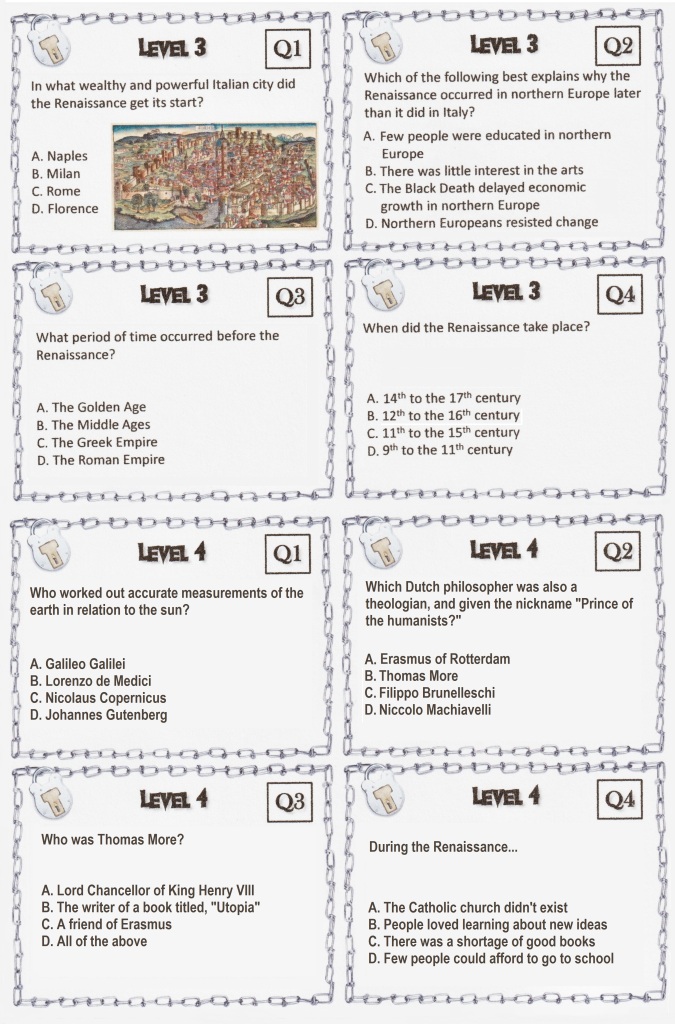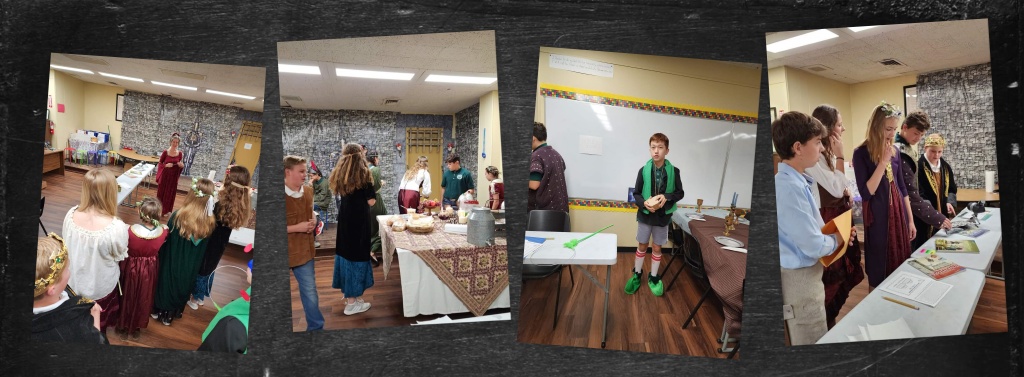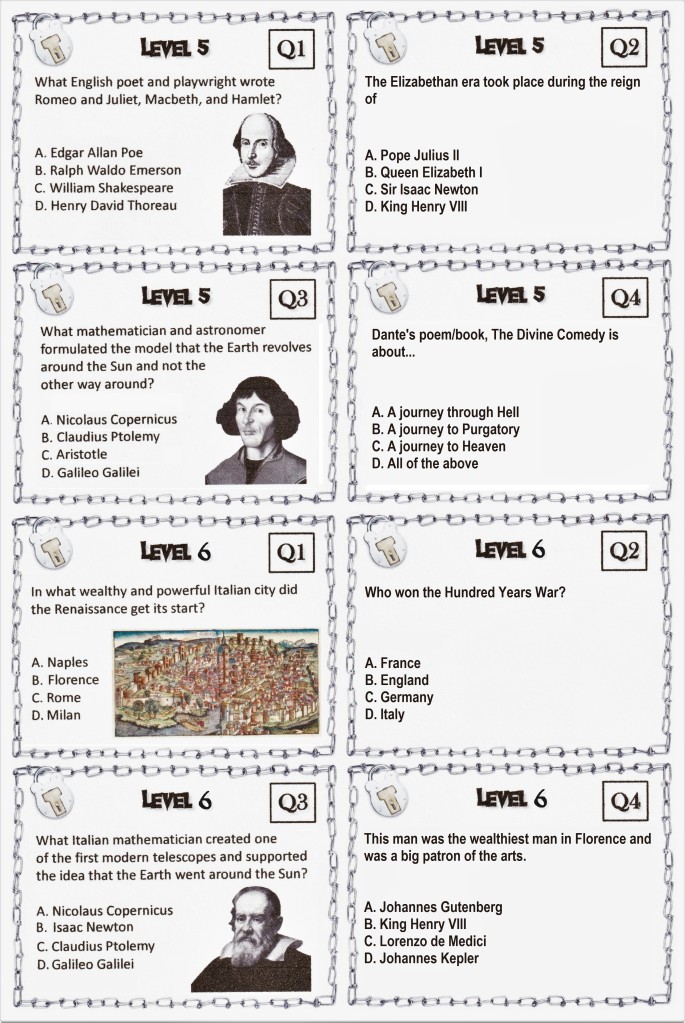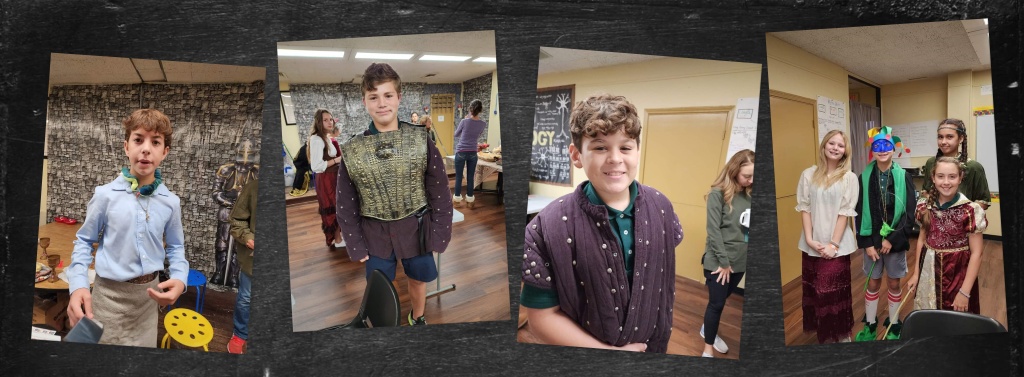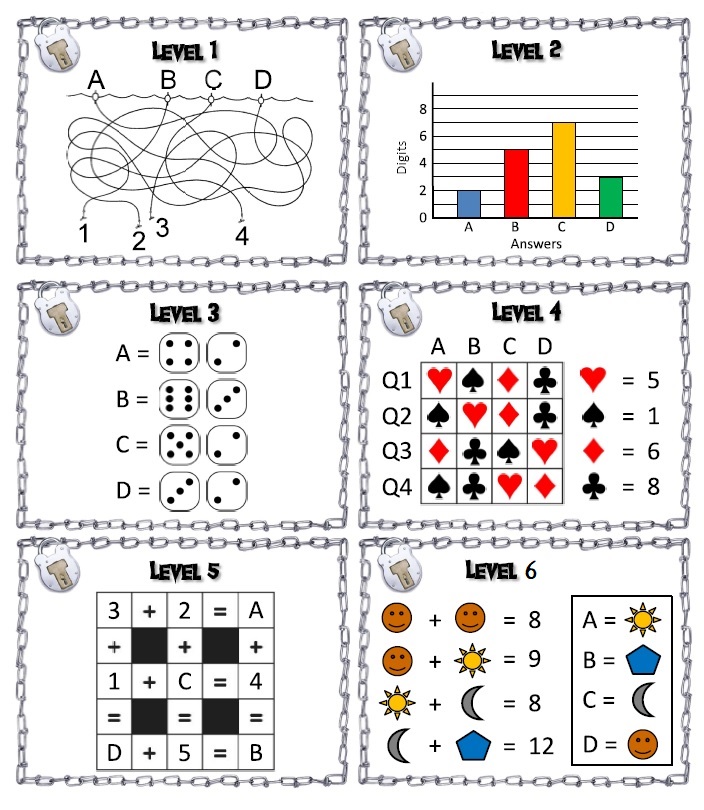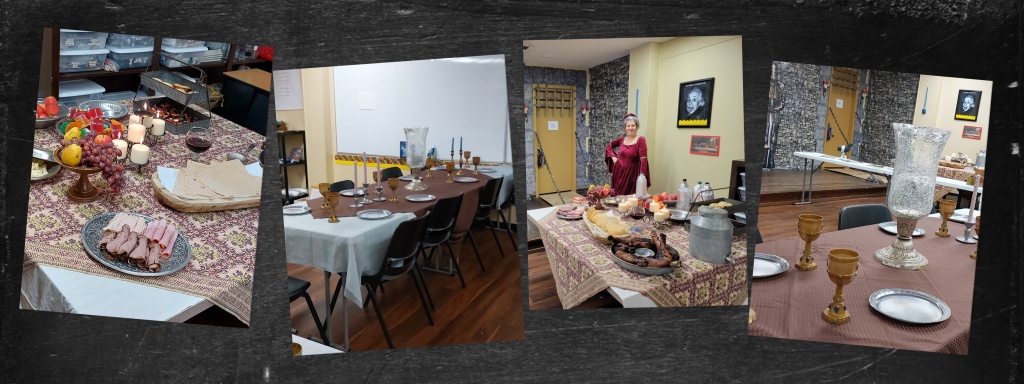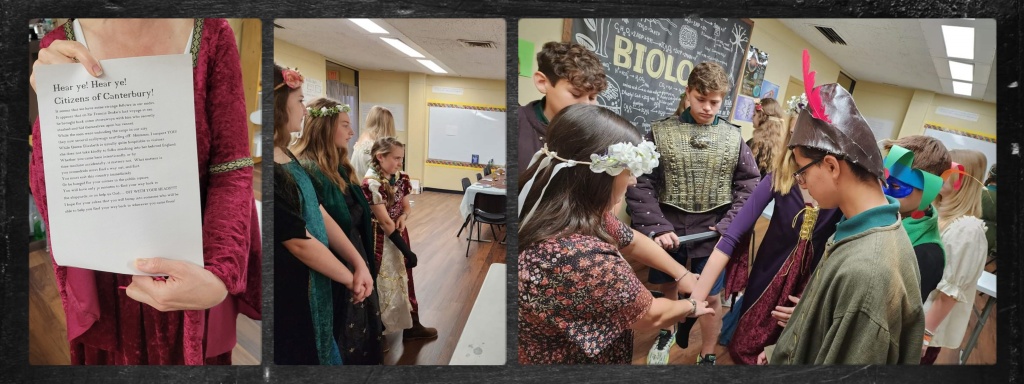
That’s the way our little affair got started. Let me tell you the tale of a Renaissance Escape Room that happened recently, one very foggy mid-autum’s day. The Jr. High students of our quaint little school had been looking forward to this day for weeks. They picked out costumes from the Drama Department’s costume closet and daydreamed through chapel just waiting for the chance to crowd into their classroom and see what awaited them there. Their laughter and excitement filled the room, but in just a moment it was all abrutly interupted by aTown Crier with news! She shouted out to them in a booming voice, and that is when they discovered their mission.
She then exited stage left and our dear “Mrs. Hollingsworth” appeared (which just so happens to be a real English renaissance family name from my own family’s history – how about that for a little historical fiction to go with our turkey legs). She was dressed as the rest, but in a red velvet costume, and when she cleared her throat a faux English accent came out. She addressed the students thustly:
“Hello, I am Mrs. Hollingsworth. I’ve come to help you. We are going to have to be sneaky and very quiet so as not to draw attention to ourselves. We’re going to need to split up. Here, I’ve put some slips of paper in this black sock. Each of you must draw a slip out and then sort yourselves into your teams.
White team, your area of the room is over there. [she pointed]
Red team, yours is over there. [she pointed]
And Green, yours is there. [she pointed]
You must stay in your area until you have completed your tasks. I’ve put together an envelope for each team. You will find them once you enter your area. Read the outside of the envelope and follow its instructions.
Your knowledge of the Renaissance is all that will save you now. Okay, be off!!!!! And good luck.“
The room was divided into 4 areas, using long classroom tables. Each area was clearly labeled, Red, White, and Green. The kids were divvied up into their 3 groups and sent away to their respective areas to begin their escape. It started with reading the outside of the envelope and then dumping out the contents. They had the choice of solving a puzzle that would tell them where to look for their 8 questions, or they could just look for them if they were feeling lucky. Most decided “just looking” sounded good. They found questions stuffed in bottles, and questions stuffed in boxes, others stashed in books , and books made out of boxes. They were high up and low down, on top of things, and underneath.

Let’s start with the Envelopes, please…
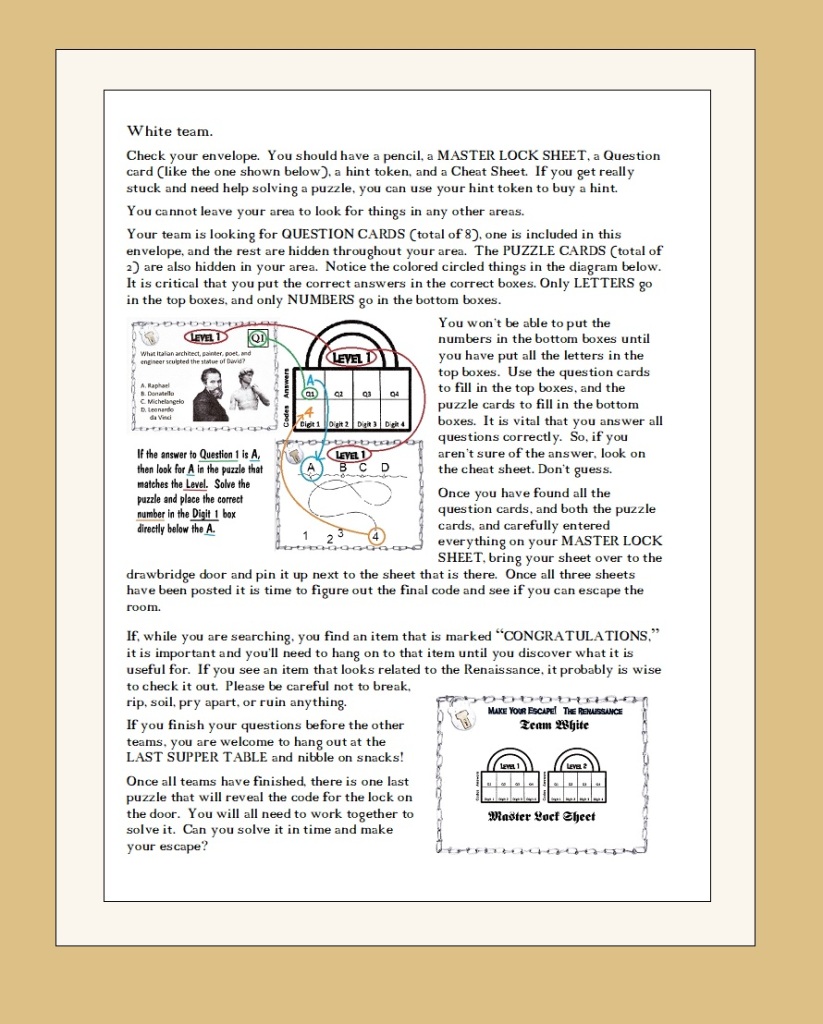
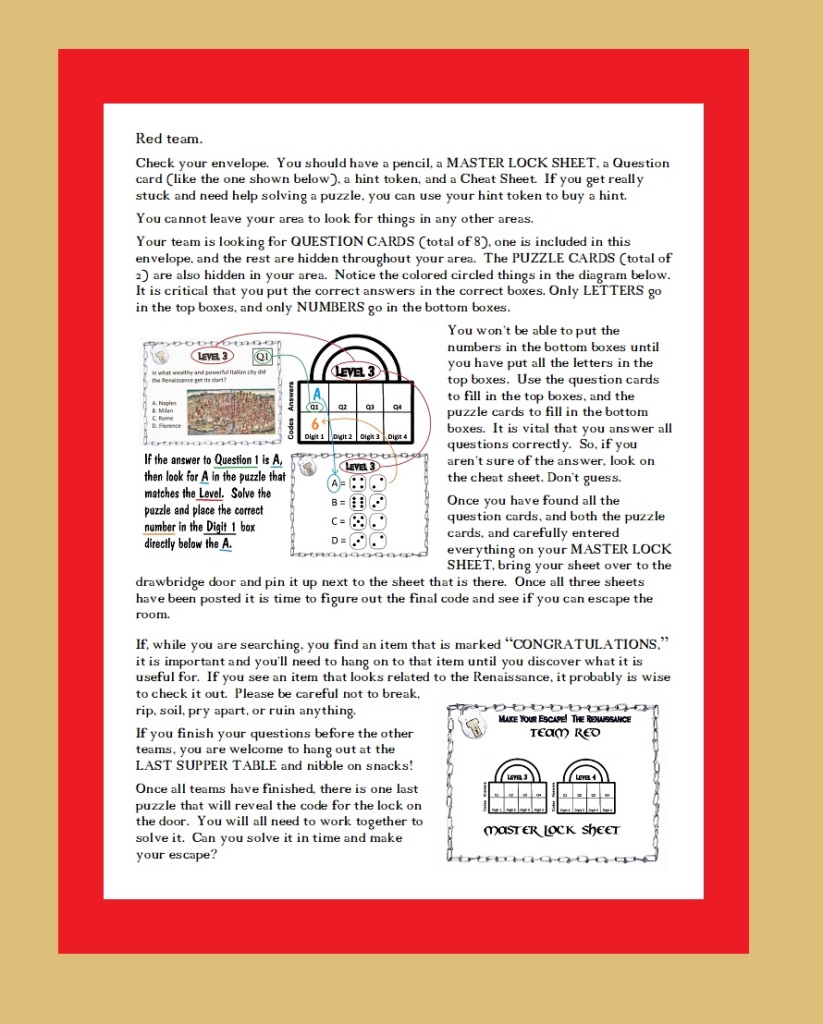
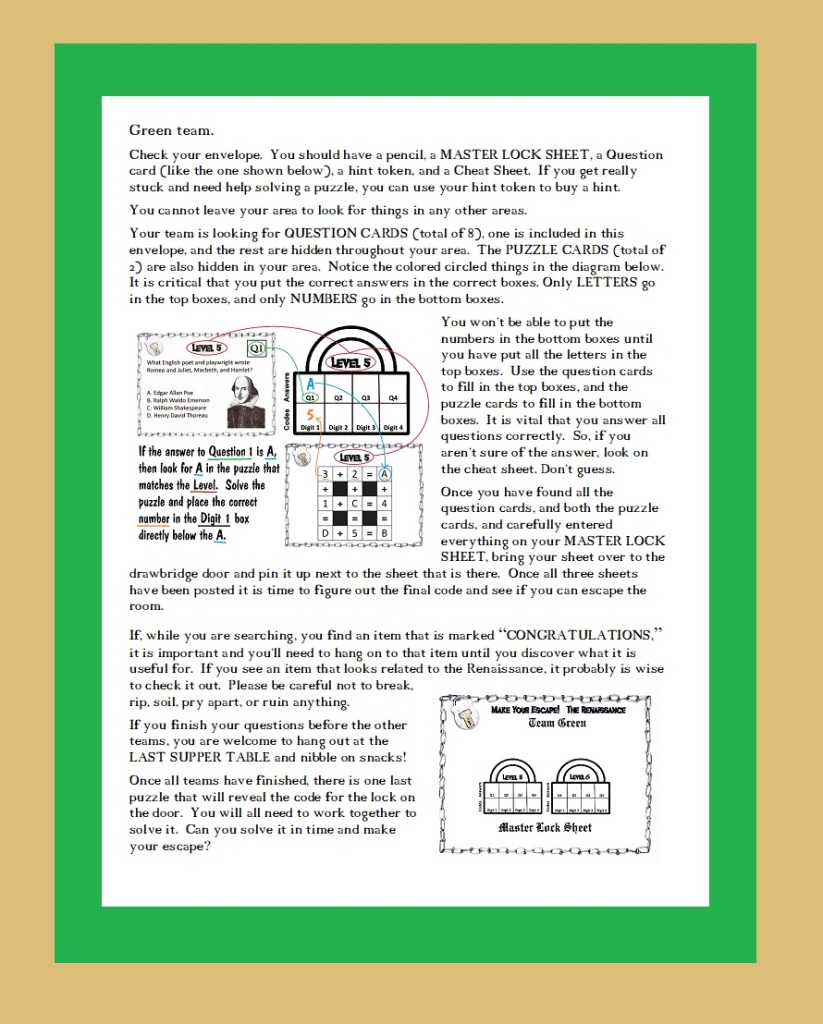
(In the interest of full disclosure, the images on the envelopes for the questions and puzzles were taken from a purchase of materials at Teachers Pay Teachers. I’ll tell you more about that a little later in this post. But I used their template for the question cards,although I made many of my own questions using our school’s World Studies Textbook, along with information found in various other books, such as these, and some online sources).
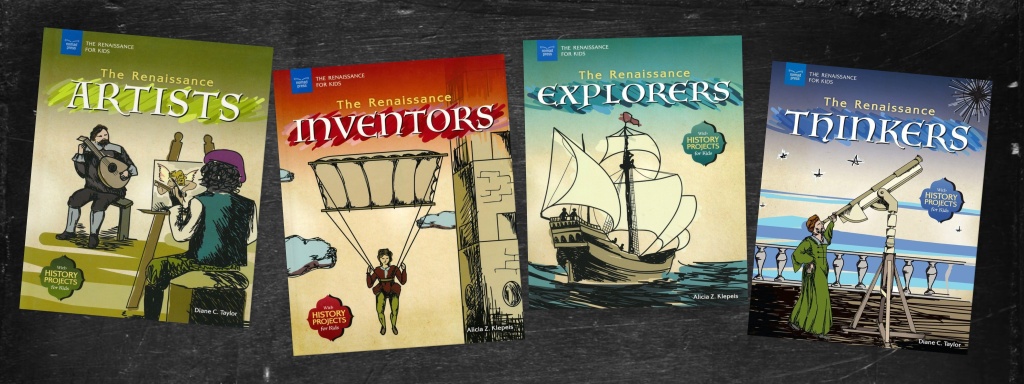
I organized all the Level One questions to be about Famous Artists & Architects of the Renaissance. Level Two questions were about Famous Explorers & Navigators of the Renaissance. Level 3 questions were about Famous Inventors & Humanists of the Renaissance. Level 4 questions were about Famous Thinkers & Philosophers of the Renaissance. Level Five questions were about Famous Writers & Composers of the Renaissance. And, Level Six questions were about Famous Mathematicians & Influencers of the Renaissance.
I made a cheat sheet for each team, printed on both sides. I wanted them to be able to check their answers, but also, since I had included some information that wasn’t in their textbook, I wanted them to be able to find the correct answer for the things they didn’t know about. Here are the CHEAT SHEETS, and QUESTIONS, and MASTER LOCK CODE SHEETS for each team…
| Level One Questions Cheat Sheet. Did you know that the Renaissance was a “rebirth” of art and architecture, deliberately anti-Gothic/Medieval? Because of the wealth of citizens, and the church, many works of art were commissioned (that means the artist was hired and paid a certain amount of money for his creation). During the Renaissance the wealthiest and most influential members of Italian society were called Patricians. Before the Renaissance, only royalty, religious leaders, and the very wealthy could afford to have their portraits made. The Renaissance produced a booming economy, and ordinary people could then afford such things. There was a humanist (human virtue) interest in art, and a renewed interest in mythology as subject matter for art. The Medici family, the richest and most prominent family in Florence, used their wealth to sponsor new artists and help fund the humanist movement. The Medici family became wealthy from banking, mining, and trade. The Medici family paid Brunelleschi to build a massive domed cathedral in Florence. Brunelleschi studied ancient Roman ruins to help create his unique architecture. Architecture during the Renaissance combined perfect mathematical proportions, domes, and classic columns. Religious works, portraits, and landscapes were mostly displayed in public; while mythologies and nudes were generally displayed in private homes. Some of the greatest artists and architects of this period are listed below. |
Famous Artists and Architects of the Renaissance:
• Filippo Brunelleschi – famous for the dome of the Cathedral of Florence
• Ghiberti – famous for the doors of the Baptistry of Florence
• Sandro Botticelli – famous for his Adoration of the Magi, Primavera, and The Birth of Venus
• Titian – famous for The Assumption of the Virgin, Pesaro Madonna, Bacchus and Ariandne, and Venus of Urbino
• Leonardo da Vinci – often referred to as a Renaissance man, was a painter, sculptor, architect, inventor and writer. He created the most famous painting in the world, The Mona Lisa. Her portrait demonstrated his mastery of 2 new painting techniques, Sfumato (blends colors to create a smoky effect) and Chiaroscuro (uses light and dark to create depth and texture). Some other paintings include Adoration of the Magi, The Virgin of the Rocks, and The Last Supper. His sketch books contained drawing of various machines, some that could be used as military weapons, and others that were beneficial to the advancement of medicine. The final drawing in his sketchbooks was the Vitruvian man inside of a square and a circle. The term Renaissance Man refers to a person that was talented in may areas.
• Raphael – was a painter and architect born in Italy. He painted his greatest work called The School of Athens. He also did an oil painting called The Sistine Madonna. It features two cherubim (angels) at the bottom. These angels have been featured on stamps and t-shirts, and many other memorabilia of modern day.
• Donatello – famous for his Bronze David and his later stone David sculptures, as well as many Biblical figures, his innovation of shallow bas-reliefs, and his larger architectural reliefs.
• Michelangelo di Lodovico Buonarroti Simoni, otherwise known by his first name. He created a statue of David which features realistic muscles, joints, and veins. His works also include the sculptures of Bacchus and Pietà, and painting of the Sistine Chapel ceiling, which was commissioned by Pope Julius II. He also designed the dome on top of St. Peter’s Basilica in Rome.
• Giotto di Bondone – was the first Renaissance painter in Florence, Italy. He broke away from the typical Byzantine style. He painted people and objects that looked natural, not abstract. His paint style became knows as realistic painting.
| Level Two Questions Cheat Sheet. Did you know that the Renaissance was a “great re-awakening” of exploration and navigation? During this period, there was a great renewal of interest in the ideas of ancient Rome and Greece. Many of the leaders of the Renaissance, who were born in the different city-states of Italy, found inspiration in these ancient writings and wanted to know more by studying art, architecture, and culture. Some brilliant minds pursued knowledge through the study of math, geography, and science. All of this expansion of knowledge contributed to the exploration of the world, which was both good and bad. The famous Silk Road, a once-prosperous trading route, had become very dangerous with tribal groups reclaiming land and charging fees for passage, or taxes on goods. Europe was desperate to find a route to China and India (where their most treasured exotic goods came from), that would avoid these dangerous middlemen. Many explorers and financiers of the age were also unfortunately desperate for fame and fortune and conquest. Part of the reason explorers were able to travel farther from home had to do with advances in navigation and shipbuilding techniques. Not only did Europeans hope to find direct routes to places with exotic goods, some European kings and queens were inspired to send expeditions out for religious reasons as well. |
Famous Explorers & Navigators of the Renaissance
Niccolò De Conti – was a self-funded explorer, mostly by land, and one of the first Europeans to reach Indonesia and Burma. He shared many exciting stories about people, spices, animals, and geography. His travels helped to improve maps of Asia, such as the Genoese, and his experiences also helped to create a map of the world.
Christopher Columbus – made 4 legendary voyages. His maiden voyage was funded by Ferdinand and Isabella (King and Queen of Spain) in April, 1492. That voyage included three ships, the Niña, the Pinta, and his flagship, the Santa Maria. He named the first island where he landed San Salvador, in hopes that the natives would find “salvation in Christ.” He is credited with discovering the “New World.”
Vasco de Balboa – is best known for the discovery of the Pacific Ocean. Balboa started a European settlement in Antigua del Darien, on the east coast of Panama. Hearing that there was a sea on the south side, he journeyed across the Isthmus of Panama and sighted the Pacific Ocean while standing on a peak. The Spaniards called the Pacific the Mar del Sur (South Sea). The expedition descended the mountain and become the first Europeans to navigate the Pacific Ocean off the coast of the New World.
Hernán Cortés – is famous for a legend where off the coast of Veracruz, he burned his ships in a do-or-die effort to conquer the land. He warred against the Aztecs and their leader Montezuma II, and lost all of his treasure and most of his men in The Sad Night.
Amerigo Vespucci – a great navigator, explorer, cartographer, and cosmographer and is where the continents of the Americas got their name.
Ferdinand Magellan – was a Portuguese explorer and navigator who led the first successful circumnavigation around the word. Unfortunately, he did not finish the journey, but his surviving crew members managed to complete this history-making voyage. He was the first observer of a previously unknown species of penguins, discovered galaxies, and was the first European to cross the great Pacific Ocean. He discovered a shortcut through Chile in South America, which became known as the Strait of Magellan. Besides the strait, Ferdinand Magellan also has a rail car (Ferdinand Magellan Railcar), lunar craters (Magelhaens and Magelhaens A), and even a penguin species (Magellanic penguin) named after him. His expeditions showed clearly that all the world’s oceans were connected.
Marco Polo – though born very early in the Renaissance period, probably inspired some of the enthusiasm for exploration through his book, “The Travels of Marco Polo.” Young Marco became a trader, traveler, adventurer and storyteller. His life inspired a children’s game that is still played today.
Juan Ponce de Leon – was rumored to have been looking for the “fountain of youth.” Served as the first governor of Puerto Rico.
Sir Francis Drake – Accompanied John Hawkins in a voyage of the slave trade. Became a privateer who attacked and plundered other ships. Was considered a pirate by the Spanish, but a hero by the English. Was given a fleet of 5 ships by Queen Elizabeth I and his expedition was only the second in history to sail around the world. He brought back lots of treasure for the queen. The queen knighted him and he was known as Sir Francis Drake thereafter.
John Cabot – was an Italian explorer sent by King Henry VII of England to the New World. It is believed that he landed in what is now called Newfoundland, in Canada, and was the first explorer to find that part of the world since the Vikings who had traveled there many centuries before. On his second voyage his ships were lost at sea and the fate of John Cabot is uncertain.
Bartolomeu Dias, Vasco da Gama, and Pêro Da Covilhã are a few other famous explorers, but there’s not enough room to talk about them.
And these were the questions that were hidden all over the room (inside of books, and boxes, and bottles, etc.)
This was their code sheet:
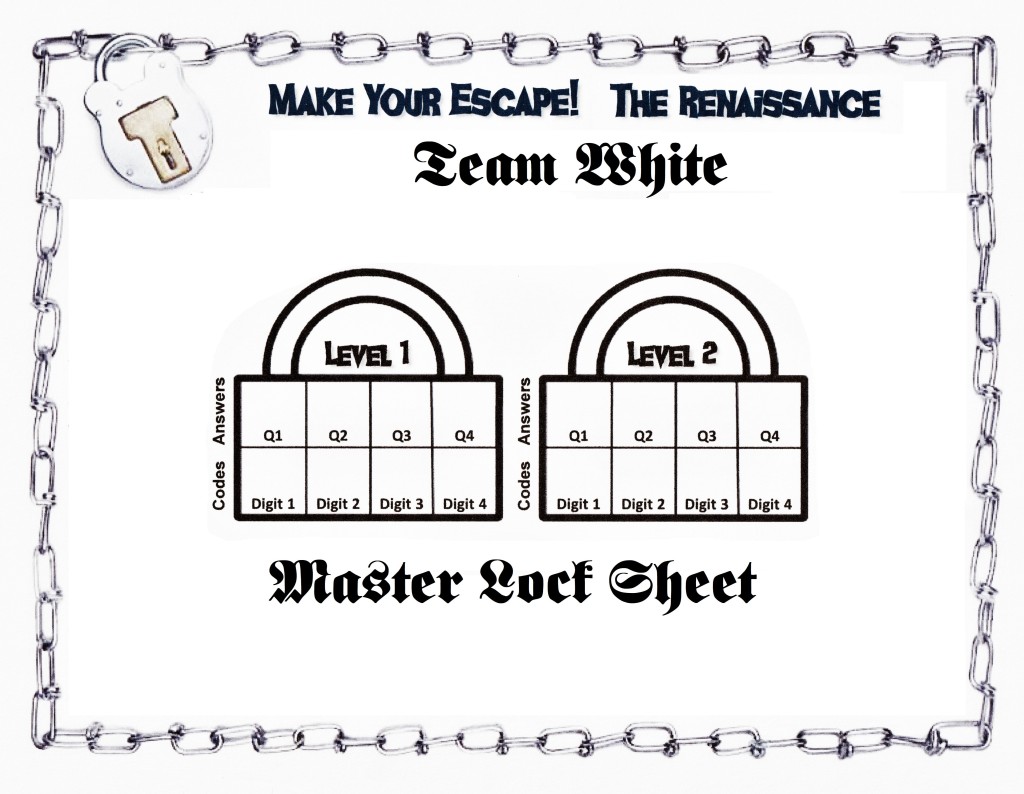
…
| Level Three Questions Cheat Sheet. The Renaissance began in Florence, Italy somewhere in the 14th century (1301 to 1400) and lasted until sometime in the 17th century (1601-1700). Humanism played a big role during the Renaissance? Humanism was a cultural movement, and idea that everyone should seek to be educated in arts, science, and literature. It was a time when human emotions were expressed in the form of art. It made the people think about their own lives and less on spiritual ideas. This new idea about education and emotional art quickly spread to Venice, Rome, and Milan, Italy. Eventually, new ideas spread throughout Europe. The start of the Renaissance brought an end to the Middle Ages. The fall of Rome brought the beginning of the Middle Ages. People were more consumed with survival during the Middle Ages. They didn’t have money or time to learn or to study. They were mostly poor farmers/peasants serving the royal class. Advances and progress in science, art, and government were lost during the Middle Ages. This part of the Middle Ages was referred to as The Dark Ages. The Renaissance was a time to “come out of the dark.” Renaissance means “rebirth.” The Black Death delayed economic grown in northern Europe. Many believe the Renaissance began with the invention of the printing press. The printing press made books and written materials more easily available, and because of the rise of the middle class and new found wealth, people were eager to learn and prosper. People began to feel better about themselves and optimistic about life. |
Famous Inventors & Humanists of the Renaissance
Erasmus of Rotterdam – was one of the most highly regarded and influential scholars of the Renaissance. He mastered Latin and Greek. He was the first to publish a Greek New Testament, which was an essential tool for the Reformation.
Leon Battista Alberti – a humanist author, artist, architect, poet, priest, linguist, philosopher, and cryptographer.
Thomas More – was a close friend of Erasmus and served in the court of King Henry VIII of England. His work, Utopia (which means “nowhere”) is a story about an imaginary country based on Christian principles, and the philosophy of Plato. In this work More presented his view of an ideal state. More supported the supremacy of the Pope and rejected the Reformation.
Johannes Gutenberg – inventor of the printing press
Leonardo da Vinci – inventor of many, many, many types of machines.
Galileo Galilei – was
Niccolò Machiavelli – created a new branch of political science based on humanist principals, where human interests were the priority.
Francesco Petrarch – was known as the “Father of Humanism.” He studied Ancient Rome’s poets and philosophers. His poetry became inspirational to other writers.
…
| Level Four Questions Cheat Sheet. During the Renaissance, people loved learning about new ideas and having their old ideas challenged and changed. They were thirsty for knowledge about art, biology, mathematics, astronomy, chemistry, literature – everything! The printing press made it possible to mass produce books. As books became readily available, more people learned to read, and new ideas spread faster than ever. During the Middle Ages, the Catholic Church played an enormous role in European life, but during the Renaissance people began to have different religious views. The first book to be printed on a printing press was the Gutenberg Bible. During the Renaissance, people (called humanists) were more interested in finding and studying the original versions of texts. They began to interpret writings in different ways, and to ask questions. Universities across Europe played extraordinarily significant roles in the Renaissance and the Reformation. They hosted innovative research in many fields and changed forever European religion and society. Universities and their professors may have had greater influence on society in the Renaissance and Reformation than in any era before or since. That influence endures to this day. |
Famous Thinkers & Philosophers of the Renaissance
Francis Bacon – argued for an approach to scientific research based on observation and reason.
Desiderius Erasmus (of Rotterdam) – was a Dutch philosopher and Catholic theologian. Among the humanists he was given the nickname “Prince of the Humanists,” and has been called the “crowning glory of the Christian humanists.” He wanted to introduce humanistic enlightenment into the Catholic Church without breaking with Rome. He mastered Latin and Greek. He was the scholar behind what is now known as the Textus Receptus, when the only Bible available at the time was the Latin Vulgate. His versions were used by Martin Luther for his German translation, and William Tyndale for the first English New Testament, and also contributed to the Robert Stephanus edition of the Geneva Bible and the Authorized (KJV) Bible.
Thomas More – a close friend of Erasmus, served as lord chancellor in the court of King Henry VIII. His work, Utopia (which means “nowhere”) was a book of social and political satire which presented his views of an ideal state.
Filippo Brunelleschi – was at first a goldsmith, and made a living making jewelry. He competed for the commission of the Baptistry doors, but bowed out when they wanted to team him with another artist and went to Rome. While there, he studied ancient Roman ruins, and in the process of making detailed drawings of them, rediscovered a lost artistic technique known as linear perspective. He also solved major problems in architecture and was able to construct the largest dome ever built without wood supports. Because Brunelleschi never wrote down his designs, historians have struggled for centuries to unravel the secrets of his success. It is still not fully understood how he accomplished what no one else has ever been able to do.
Niccolo Machiavelli, an Italian philosopher, created a new branch of political science based on humanist principals, which emphasized human interests over religious views. He wrote groundbreaking books about politics. One small “mirror book” called The Prince, which has been translated into dozens of languages and read by millions. Adolf Hitler and Joseph Stalin kept a copy of it on their nightstands. His last name became a euphemism for everything bad in politics. Lying, cheating, scheming, backstabbing, killing—are all qualities associated with Machiavellianism.
Nicolaus Copernicus – worked out accurate measurements of the earth in relation to the sun.
Garardus Mercator – outlined an approach to scientific inquiry that changed several branches of science. Queen Elizabeth gave him the nickname, “Little Lord Keeper.” He was the first English writer to use an “Essay” format.
And this was their code sheet:
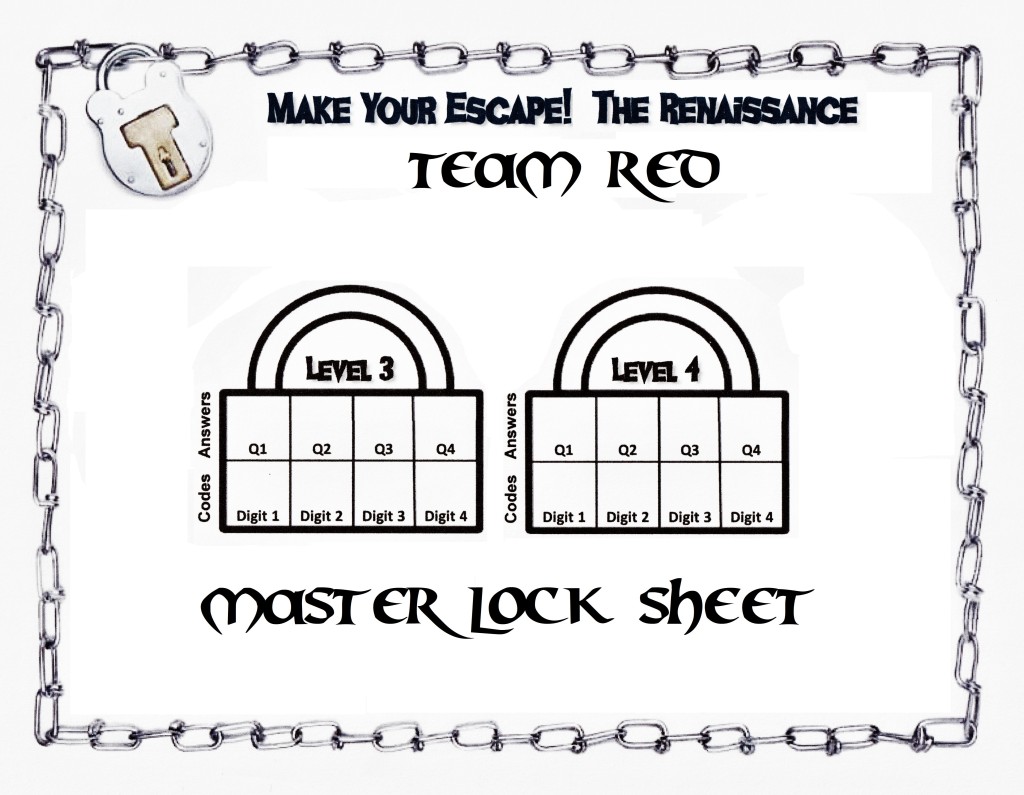
| Level Five Questions Cheat Sheet. Thomas a Kempis authored the book, The Imitation of Christ, which is still in print today. The Canterbury Tales is a collection of twenty-four stories written in Middle English by Geoffrey Chaucer and can also still be purchased today. Did you know that the Elizabethan Era is famous for the works of William Shakespeare? It was the Tudor period of England’s history, during the reign of Queen Elizabeth I. This “golden age” represented the apogee (which means the peak or highest point) of the English Renaissance. The era is most famous for it’s theatre, but it was also an age of exploration and expansion abroad. The circumnavigation of Francis Drake brought wealth to England. |
Famous Writers & Composers of the Renaissance
William Shakespeare – was an English playwright, poet, and actor. He is credited as having written 39 plays, 154 sonnets, 3 long narrative poems, and a few other verses. His most notable works are “A Midsummer Night’s Dream,” “All’s Well That Ends Well,” “Anthony and Cleopatra,” “Romeo and Juliet,” “Hamlet,” “Macbeth,” “Othello,” “The Comedy of Errors,” “The Taming of the Shrew,” and many more.
Petrarch – was a scholar and poet of early Renaissance Italy. One of the earliest Humanists. His rediscovery of Cicero’s letters is often credited as initiating the Renaissance. His notable works include odes and sonnets to Laura, the idealized subject of his chaste love, Triumphs, Canzoniere, Secretum Meum.
Dante Alighieri – wrote his narrative poem/book, the Divine Comedy in 1308. The first part of this epic poem is Inferno, often referred to as Dante’s Inferno. It describes Dante’s spiritual journey through hell, guided by the ancient Roman poet Virgil. It includes nine concentric circles of torment located within the earth. Inferno (hell) is followed by Purgatorio (Purgatory) and Paradiso (Paradise/heaven). His book is considered the greatest piece of literature written in Italian. Iconographic images from Donte’s Divine Comedy have been painted inside the dome of the Cathedral of Florence, the brainchild of Brunelleschi.
Nicolaus Copernicus – was an astronomer and one of a handful who believed that the sun was at the center of the universe and that the earth and planets revolved around it. He proved in his book, On the Revolutions of Heavenly Spheres, that the heliocentric model was correct, backing up his theory with mathematical equations. It was Johannes Kepler that later proved Copernicus right. Also, Galileo, developed telescopes powerful enough for astronomers to see for themselves that Copernicus’s heliocentric model was accurate.
Machiavelli – is famous for his little book, The Prince, which was a how-to or guidebook for rulers. He was called a lot of bad things, including “devil” and “monster,” but nothing indicates that he was ever terribly “Machiavellian.” He was influential, but never sought power for power’s sake. And every devious strategy he described in the book was based on the actions of others.
Erasmus of Rotterdam – was known as the “Prince of the humanists.” Was a friend of Thomas More and was staying at his home when he composed what is considered one of the most important works of the Renaissance, “In Praise of Folly.” In this work, Erasmus took a humorous approach to old superstitions and corruption in the Catholic Church. He dedicated the essay to More.
Sir Thomas More – was famous for his book, Utopia, which was his idea of the ideal society. He was very religious and served as lord chancellor to King Henry VIII.
Castiglione wrote a book on manners and etiquette (social behavior). His book was titled, The Courtier.
…
| Level Six Questions Cheat Sheet. Did you know the Renaissance began in Florence, Italy somewhere between 1350 and 1400 and lasted until the mid 1600s. The Hundred Years War took place between 1337 and 1453 and ended in a French victory. During the Hundred Years War, a peasant girl from France named Joan of Arc believed she was being led by God to drive out the English. The French defeated the English under her leadership, but the English later captured her and burned her at the stake. The Black Death may have started in China and by 1347 had spread to. It claimed the lives of an estimated twenty-five million Europeans. The Renaissance (which means “rebirth”) was a period of great awakening of classical arts, culture, science, medicine, education, literature, art and music. It was a time to “come out of the dark.” The Renaissance began as more and more people were able to afford to learn to read and write, the printing press made printed materials more available, and the Italian seaports traded goods as well as new ideas. |
Famous Mathematicians & Influencers of the Renaissance
Nicolaus Copernicus – was the mathematician and astronomer who formulated the model that the Earth revolves around the Sun and not the other way around.
Galileo Galilei – was an Italian mathematician credited with creating the first modern telescopes, which supported Copernicus’s idea that the Earth revolves around the sun.
Johannes Kepler – was a German astronomer, mathematician, astrologer, natural philosopher, and writer of music. He is best known for his laws of planetary motion, as well as his books Astronomia Nova, Harmonice Mundi, and Epitome Astronomiae Copernicanae. He was a contemporary of Galileo Galilei.
Johannes Gutenberg – was a German inventor, printer, publisher, and goldsmith who introduced printing to Europe with his mechanical movable-type printing press.
Henry VIII – was king of England from 1509 to 1547. He is credited with initiating the English Reformation by separating the Church of England from papal authority. He appointed himself Supreme Head of the Church of England. He also invested heavily in the navy. He made radical changes to the English Constitution.
John Calvin – was a French theologian, pastor, and reformer in Geneva during the Protestant Reformation. He developed a system of doctrine known as Calvinism.
Elizabeth I – was Queen of England and Ireland from 1558 to her death in 1603. She was the daughter of Henry VIII.
Pope Julius II – was head of the Catholic Church and ruler of the Papal States from 1503 to his death in 1513. He was nicknamed “the fearsome Pope.” He chose his name in emulation of Julius Caesar. He was one of the most powerful and influential Popes. He established the Vatican Museums and initiated the rebuilding of the St. Peter’s Basilica. He invited Raphael to decorate some rooms in the Vatican. The Catholic Church – used their wealth to make extravagant cathedrals, ornately decorated inside with architecture, paintings, sculptures, expensive doors, and domes.
Martin Luther – was a German priest, author, and hymnwriter Catholic friar responsible for starting the Protestant Reformation.
Lorenzo de Medici – was a poet, known as Il Magnifico (“The Magnificent”), the wealthiest and most powerful man in Florence. He was a supporter of humanist thinkers and a great patron of the arts.
And this was their code sheet:
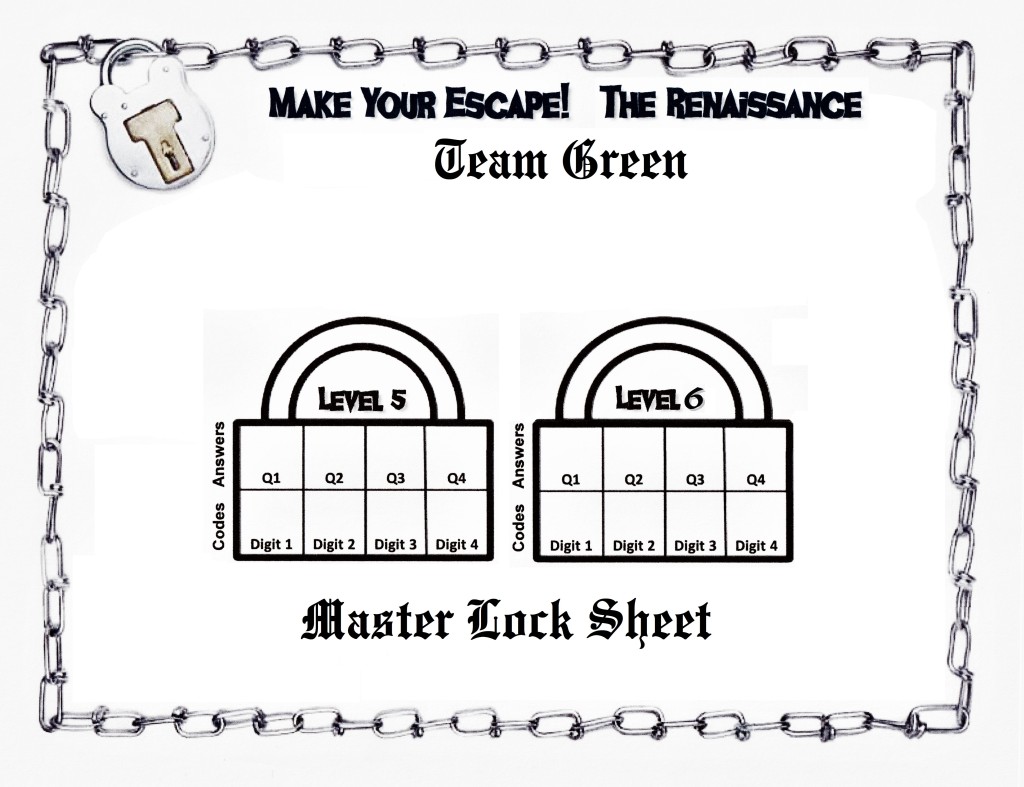
…
The Question cards were hidden individually all over the room, but each team needed 2 puzzle cards and those were hidden together in a locked box for each team. The students had to find and answer all their questions correctly (8 per team), plus find the key for their locked boxes (which I hid in books and in a soup can), and also the locked boxes themselves. Once they figured out the codes for each of the the Questions. Those codes would then be used for finding the FINAL MASTER CODE that would unlock the final “Escape Door.”
These were the puzzle cards I used, and I got them from a kit I purchased of a Renaissance Escape Room. This is where you can get your kit: Escape Room EDU @ Teachers Pay Teachers. It is very well done and very inexpensive. They actually designed it to be used in connection with the internet, but it works easily without it. Since there is nothing on the website or in the printed materials to forbid me sharing these images with you I included them here. Please, though, go visit that website and download your own complete kit. Please support the hard working people that put these awesome things together. It is only a few dollars and very well worth it. I altered the Level 6 card.
Once some of the students had finished this first part, they needed to wait for all the teams to finish in order to go on to the next part as one big group. So this is when they were invited to feast. And what a feast it was!!!!! Bread and wine (okay, grape juice), grapes and pears and apples, cheese curds, jello – did you know that gelatin was invented (discovered?) in the Renaissance?, carved meats and roasted turkey legs, pies and tarts., beer and ale (okay Root beer, and Ginger ale). The kids sat at a table fit for King Henry VIII.
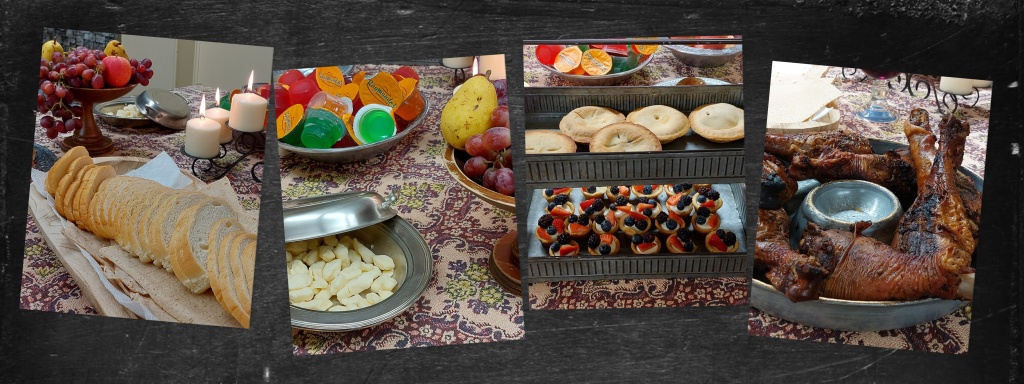
…
After about 10 minutes, since no one had noticed a certain incognito item that was crucial to the success of the mission, I asked if anyone had seen the tag thing that was hanging from Da Vinci’s the LAST SUPPER painting, which was hanging on the wall by the table of food. Of course the kids made a bee-line over there to check it out.
…
The tag was attached with a string to a note that was taped to the back of the painting. It said:
“What is missing from DaVinci’s Last Supper Table, that is always part of our Communion Table?”
…
They searched and searched…
…and someone blurted out, “THE CHALICE!”
…
Under the CHALICE was a note tucked inside of a little blue envelope that said:
“Look under the drawbridge!”
…and so they did!
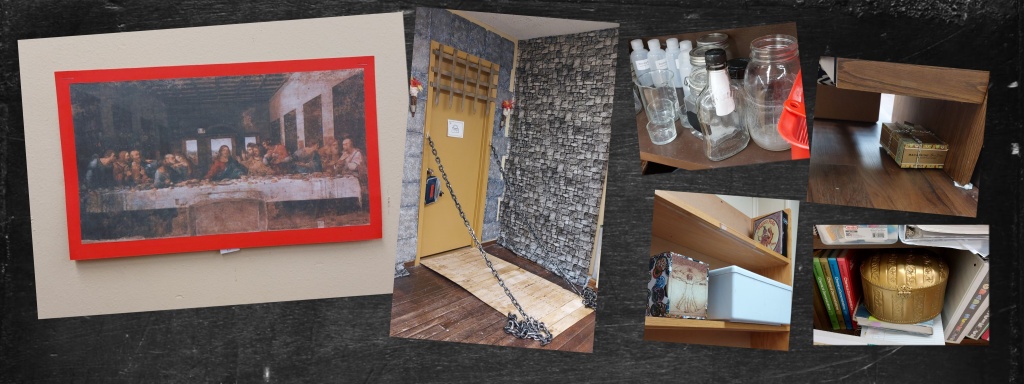
…
Under the drawbridge was this TAP CODE/Polybius Cipher puzzle which needed to be solved. It required all teams to come together with their Master Lock Code Sheets, plus the box that had the 3 colored blocks in it (which hadn’t served a purpose yet), and a cipher key.
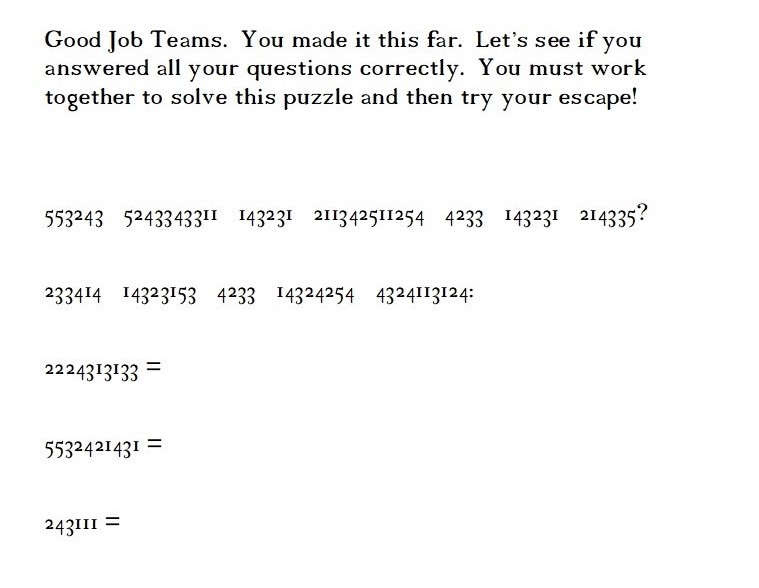
This was the cipher key to the TAP CODE/Polybius Cipher:
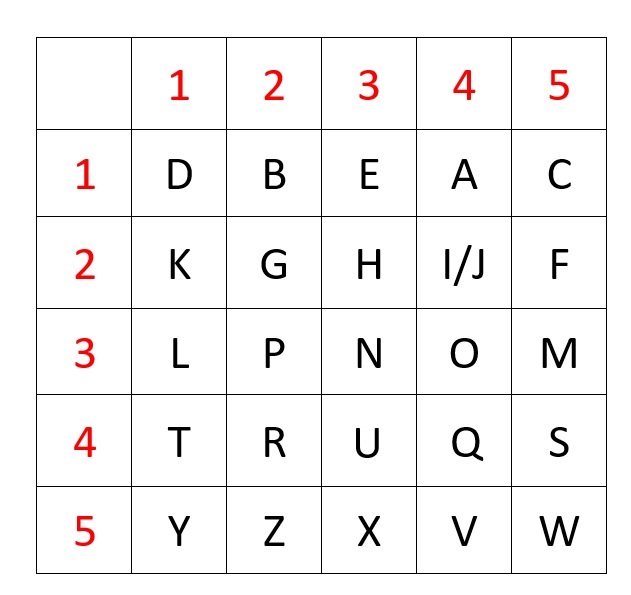
If you’ve never done one of these before, each letter of a word is represented by two numbers. It helps if the first thing you do is draw a slash between each pair of numbers in the puzzle. Then tackle the first pair, which in our case is 55. First go 5 spaces across the top, and then 5 spaces down. So 55 equals W. 32 is 3 spaces over and 2 spaces down and is an H. 43 is 4 spaces over and 3 spaces down, which is O. So, the first word is WHO. To make the puzzle more challenging, remove a few letters in this key.
After solving the puzzle, the question is asked, “Who found the blocks in the box?” One of the kids remembered and ran and grabbed the box. There were three blocks in the box. One block was Green, one was White, and one was Red. The Green block had a code written on it: “Level 3/Q2/Digit2” (or something like that). The White one and Red one also had a similar written code. Each number of the escape code came from a different team’s code sheet.
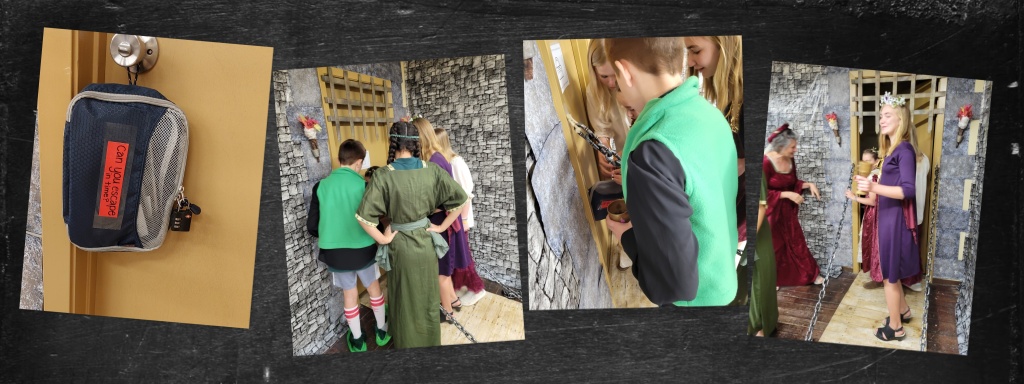
…
The kids were sure they had figured it out. They jumped up and ran to the door. They twisted the numbers on the wheels of the luggage combination lock to enter the code: [?] [?] [?] and voila, SUCCESS!!!!!!!!! The lock popped open and the kids escaped, exactly 30 seconds before the end of the class period. YAY!!!! They got to keep their heads.
Inside the locked pouch I had placed bookmarks, one for each student, with their names on them, and an exclamation that said, “I Escaped the Renaissance!” The kids got to keep their drink goblets and the bookmarks as souvenirs. And they seemed to have had a really fun time. Half of them had to hurry off to their next class, but the other half stayed and helped me clean up, and haul all my decorations and food service out to my car. What a great group of kids.
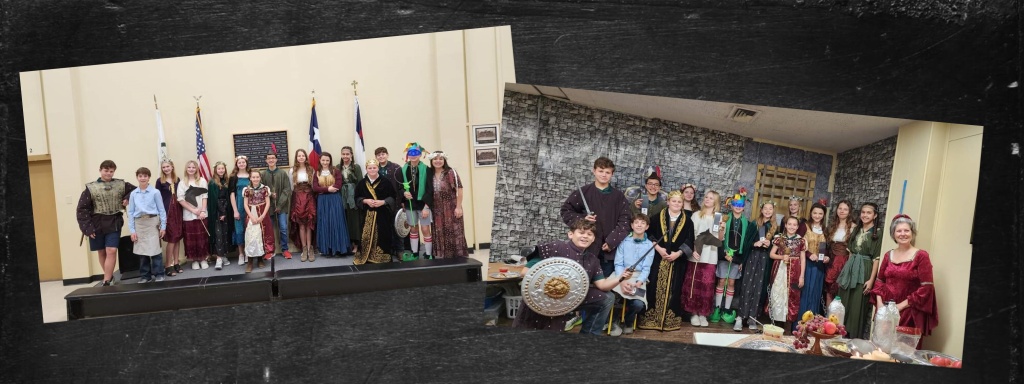
…
“To be, or not to be: that is the question.” — “Hamlet”
“All the world’s a stage …” — “As You Like It”
“O Romeo, Romeo! wherefore art thou Romeo?” — “Romeo & Juliet”
“Is this a dagger which I see before me…” — “Macbeth”
“Be not afraid of greatness…” — “Twelfth Night”
“If you prick us, do we not bleed?” — “The Merchant of Venice”
“The course of true love never did run smooth.” — “A Midsummer Night’s Dream”
“Shall I compare thee to a summer’s day?” — “Sonnet 18”

